Aquarium Guide - Gallery
Here are some notes on the care and feeding of a number of fishes and other creatures that can be wild-caught and kept in an aquarium. The size of each specimen is assumed to be 6" or smaller. This restricts some species to juveniles only. The groupings here do not imply any sort of relationships between the different species, only similarities in keeping.
Saltwater
There is no manual on how to keep temperate marine creatures in a small private aquarium. Large public aquariums manage to do it, but they have far greater facilities than a private person. After much trial and error, I can make some suggestions as to the compatibility of different species in the community aquarium:
Fast, active fishes, aggressive feeders
|
Slow, sedentary fishes, passive feeders
|
Best kept in isolation
|
Best not kept at all
|
Harmless Scavengers
|
Filter-Feeders ( doomed in aquarium )
|
Mussel-eaters
|
Live foods
|
Baitfishes
Most of these fishes are best collected with a dip net or seine while wading near the shore.

Killifishes are very easy to keep. They tolerate almost any water conditions. Killifish tend to be boisterous bullies, especially at feeding time. They will greedily accept almost any food and will overeat and foul the tank. Since they are so tough, Killifishes are useful for starting up a new tank, but I would not keep them otherwise.

The sinuous swimming and constant activity of ordinary Silversides make up for their lack of color. Silversides are physically fragile, but if handled carefully they adapt well to captivity, feeding on almost anything offered. More aggressive fishes will literally tear them apart.
Anchovies are easily caught with a dip net, but are far too fragile for aquarium keeping - 100% mortality rate, don't even try. Mullets and small Peanut Bunkers ( baby Menhaden ) are hardy fish, but their filter-feeding habits make them almost impossible to feed in captivity.
Sea Robins & Gurnards
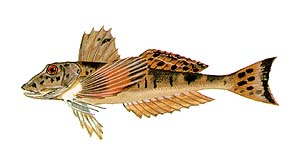
Reviled by fishermen, small Sea Robins actually make fascinating pets. When not frightened, the fish holds its huge and colorful pectoral fins fully fanned out like butterfly wings. The rest of the Sea Robin is attractively patterned as well, with orange cheeks and blue eyes on a comical face.
In the aquarium, the Sea Robin is active but peaceful, always visible front and center, constantly combing the bottom with its "fingers" as it searches for morsels of food. The only problem I can find with them is that at feeding time they may hog up everything, leaving little for their tankmates. But all in all, I would rank this fish with any exotic tropical you could buy in a store for hundreds of dollars. And you can get one for free out of the river! Cover the tank - they are jumpers.
Northern Kingfish

These attractive fingerlings are easily kept in captivity, where they are rather like catfish. The body form, swimming habits, and handsome patterning makes them look like little sharks, although they are completely peaceful. Keep the tank covered - they are jumpers.
Flounders

Baby flounders of all sorts are among the most interesting aquarium subjects you will find anywhere. They readily take live or frozen worms, and other meaty foods. Their color-changing abilities and precise control of the marginal fins is incredible. When stalking prey, they can creep forward, backward, or pivot, like a bulldozer. At other times, a quick fluttering motion is used to bury everything but the bulging eyeballs.
Flounders should not be kept with other aggressive species, since their slow-moving sedentary habits and utter inability to fight back make them easy targets. Also, they are not aggressive feeders, so care must be taken to assure that they get enough food in a mixed tank. Windowpanes ( pictured ) make especially good subjects, once they get over their initial shyness.
Puffers

Tiny baby Puffers adapt quite well to aquarium life, feeding greedily, but generally not bothering other fishes. They sleep in the sand at night.
Adults are a different story and do not take well to confinement at all, refusing all foods, and concentrating solely on frantic attempts to escape. In any case, these fish are active, aggressive, and extremely well-armed with chisel-like teeth that they will not hesitate to use on tank-mates. Except for the smallest specimens, they should be kept alone.
Sticklebacks

In captivity, Threespine Sticklebacks are pugnacious and territorial. They must be kept cool and will accept only live foods, but the colors and nest-building activities of breeding males are fascinating and well worth the effort. Four-spines are more peaceful but less interesting. They are also small enough to be considered food by most potential tankmates. All require live foods.
Toadfishes & Sculpins

Small but feisty, the Oyster Toadfish may snap at your fingers with its powerful jaws when caught. I once saw one in a bucket do a surprising amount of damage to a wooden pencil. Despite this, they are not particularly inclined to molest their tankmates in an aquarium. Instead, they are sedentary and shy, and a proper hiding place such as a small jar or flowerpot should be provided. Still, the powerful jaws and nocturnal habits make this a fish not to be trusted. Toadfishes are highly tolerant of poor water conditions and pollution and accept live and/or meaty foods. They can sometimes be observed walking on their leg-like pelvic fins, and they also dig.
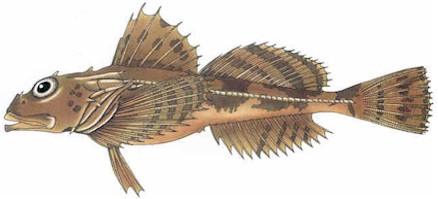
Sculpins require cool water and live foods to survive in captivity. Even then, they are neither very attractive nor very interesting. They are peaceful with other fishes too large to swallow.
Blennies & Gobies

Naked Gobies make interesting aquarium subjects, with their permanent frowns and funny hopping style of swimming. They are entirely peaceful and somewhat retiring. They readily accept live worms as food, but don't place them with anything that would accept them as food!

Although lacking in coloration ( drab brown, like most everything else around here ), the Feather Blenny more than makes up for this with its interesting habits and absolute ease of keeping. Blennies are active and inquisitive, either clumsily hopping around the tank and cleaning up any morsels of food missed by the other fish, or tidying up whatever spot it has chosen for a home. A large Moon Snail shell works well for this. This blenny is not a picky eater - accepting even dry foods almost immediately - nor does it seem to be particularly sensitive to water conditions. The "feathers", called cirri, above the eyes, are a unique feature. Male blennies care for their eggs and young.
Unfortunately, the confines of an aquarium heighten this fish's already strong territoriality. Blennies have short powerful jaws, and will readily clamp them down on anything within reach. Larger faster tankmates will be nipped to tatters, and smaller ones will be mangled and killed. Blennies are therefore best kept alone.
Both of these scaleless fishes are especially susceptible to Ich.
Pipefishes & Seahorses


Pipefishes and Seahorses are completely placid and inoffensive, and should not be kept with other types that will take advantage of this. They should be given some sort of weedy shelter to perch and hide in.
Feeding them can be exasperating. Pipefish and seahorses have tiny mouths, with which they feed on plankton. In place of this, they will accept brine shrimp, which are unfortunately not a nutritionally complete diet for them, and the animals will suffer. Large specimens can take small guppies, which are a much better food source. Worms and most other foods are ignored - they are extremely picky eaters. If you live near the shore, you may be able to collect suitable planktonic crustaceans ( which are attracted to bright lights at night ).
Pregnant male seahorses will not eat at all. In fact, the presence of a pregnant male or babies in a tank may inhibit other seahorses from eating as well. Once the babies are removed, they go back to normal and are actually voracious predators. Newly caught specimens may refuse to eat for weeks, but don't give up, they will eventually come around.
Sea Basses, Cunners & Scup

Baby Sea Basses are one of the most attractive of the local fishes for the aquarium, with handsome if subdued patterning in grayscale. They are gluttonous, and easily weaned onto ordinary dry fish foods, showing a marked liking for anything red. They are also decidedly predatory ( piscivorous - "fish-eating" ), and will devour any tankmate that fits in their mouth, which opens much wider than you might think. Sea Basses are aggressive among themselves but otherwise peaceful with anything they can't swallow. They must be kept in cool water, as they suffer in excessive heat.

Young Cunners ( 1-3") are pink to lime green, and make interesting, if somewhat nippy and territorial, aquarium subjects. They seem to enjoy tunneling under rocks and things and will eat almost anything you present them with. Like their adult counterparts at sea, baby cunners are sneaky opportunists, not above making a quick snack of a neighbor's fins. Blackfish are similar but more shy. Both types can only be kept in a community when very small, as they grow they become aggressive and dangerous.

Scup adapt readily to the aquarium, quickly learning to accept almost any sort of food. They are peaceful and active, if utterly nondescript.
Eels

Baby eels are attractive, robust, and fairly peaceful. They are also completely nocturnal and spend the days buried in the substrate. This means you will almost never see them, although their digging may upset the decor of the tank. Additionally, these fishes are escape artists who can wriggle out through the smallest hole in the aquarium cover, and they seldom find their way back in.
Butterflyfishes

In an aquarium these fishes are perpetually in motion, making them very interesting subjects. Butterflies tend to be nippy among themselves, and will also harass any slow-moving fishes in the tank. Sea anemones will be picked at mercilessly - Butterflies seem to be immune to the stingers.
The literature states that chaetodon are corallivores, or "coral-eaters", and therefore almost impossible to feed. I have found this not to be the case, perhaps because the wild-caught juvenile specimens around here have probably never even seen coral, and are already used to an alternate diet. They are fussy eaters but will learn to take live worms and brine shrimp, and eventually even dry foods. Mussels are another favorite food.
Although common, attractive, and easy to catch, I do not recommend keeping Butterflyfishes. This is because they are not very hardy, and they are extremely susceptible to Marine Ich. In fact, this parasite will use the Butterflies as a springboard to infect every other fish in the tank, even those that are normally immune to the disease. So in short - keep Butterflyfishes in a single-species tank ( and expect to lose them ) or don't keep them at all.
Miscellaneous Tropicals

Squirrelfish are robust and adapt quickly to aquarium life, taking small live foods and skittering nervously from one hiding place to another. In time they lose their shyness and also adapt to standard dry fish foods. The big mouth could make them a threat to smaller tankmates.
Squirrelfishes are uncommon tropical visitors to our area, but make much better pets than the much more common Butterflyfishes. Never use a net when handling this or any other type of spiny fish - they will become hopelessly ensnared. Instead, chase them into a container with your hand.

Baby Filefishes of 2"-3" may be found drifting along with clumps of Sargassum weed. They are also found inshore. Filefishes are related to Triggerfish.
Filefishes are intelligent ( for a fish ) and inquisitive, constantly investigating their surroundings. In an aquarium, they quickly learn who feeds them, and even will beg for food. Another interesting behavior is blowing jets of water into the sand to uncover things. Unfortunately, they may also use their chisel-like teeth to terrorize and dismember tankmates. Triggerfish are similar.

The eating power of the Sargassum Fish must be seen to be believed. It is easily capable of ingesting prey its own length, and almost its own size. The belly swells like a balloon, and you can see the outline of the folded-up victim inside. Needless to say, in an aquarium, they must be kept in strict solitary confinement, as they will angrily snap even at things they couldn't possibly swallow, and even when their belly is already full. They can be trained to take large freeze-dried krill by waving it in front of them on the end of a piece of stiff air line tubing. These fish grow very quickly if allowed to always eat their fill; growth can be controlled by sparse feeding.
Starfish, Sea Urchins & Sand Dollars

Small starfish may be kept in a coldwater aquarium, where they will eat most meaty foods. One of the easiest ways to feed them is to just throw live mussels in the tank, and let the starfish take them when they are hungry. Starfish are capable of bursts of speed ( maybe that's not the right word here ) and activity greater than you would expect. It is interesting to flip one over onto its back and see how it rights itself. Blood Stars are not very hardy in the aquarium. After several months in captivity, starfish may begin to languish and should be released.

Small urchins make hardy and interesting aquarium subjects. I have found that they will predate on anything that moves slower than they do, but that is a pretty short list - mainly snails and sand dollars. Mostly they are scavengers and algae eaters, making them highly desirable additions to the cold-water aquarium. Urchins require a specific gravity of at least 1.020, and are not suitable for a brackish water setup.
Although easily collected, Sand Dollars are poor aquarium subjects. Their feeding needs lead to a catch-22 in the aquarium: the animal needs a "filthy" aquarium to feed, but a filthy aquarium is quite the opposite of the way it should be. Add to that the fact that sand dollars seem to be highly sensitive to water conditions, and you have an animal that is difficult to keep alive for any period of time. They probably also have the same salinity requirements as urchins.

All of these creatures are extremely sensitive to aquarium fish medications and should be removed from the tank prior to any treatment. Even a trace of copper or other chemical will kill them.
Mollusks


The Mud Dog Snail ( right ) is a useful scavenger in the aquarium.
Oyster Drills ( left ) seem to be strictly predatory on bivalves such as mussels and are useless as tank-cleaners. This is made up for somewhat by the attractively patterned and colored shell.

Small mussels may be frozen for use as fish food or thrown directly into an aquarium either live or freshly crushed. Surprisingly, they do have some locomotive capability, using their siphons, although they quickly glue themselves down to anything solid.
In the long term, any filter-feeder like this is going to have a tough time in an aquarium, unless you go to extreme measures to feed it, and I don't see why anyone would. An interesting possibility would be to put live mussels inside the filter and make use of their feeding habits.
Clams and other burrowing bivalves would be of no interest, with the possible exception of swimming Scallops. Feeding any of these poses the same problems as for Mussels.
All mollusks are extremely sensitive to aquarium fish medications and should be removed from the tank prior to any treatment.
Sea Anemones, Jellies, Coral, Sponges & Algaes
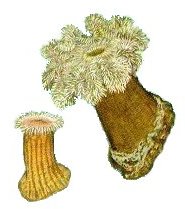

Frilled Anemones ( right ) may be kept in an aquarium if they are collected from a river or inlet site. Specimens taken from the open sea never make the transition, and end up as dead balls of goo. Place them in the tank where the water currents will bring the food to them. Anemones will take most meaty or live foods.
Striped Anemones ( left ) thrive in captivity. They seem to get plenty of whatever it is they eat just from straining the tank water, and immediately start budding off tiny babies, which crawl away from the parent to find their own spot to grow.


There is really no marine plant or algae that is worth trying to keep in an aquarium. Small pieces of Sea Lettuce ( right ) may last a long time, but seem to be useless as a food source. A mature aquarium will grow a harmless coating of brown diatoms, and occasionally green fuzz. This can be scrubbed off periodically, or left in place, depending on whether you consider it to be natural or unsightly.
Broken-off chunks of White Coral ( left ) are easily collected, but the filter-feeding polyps languish in the clean filtered water of an aquarium, and in time they shrink away and die. The same is true of Sponges, which are attractive and colorful, but soon die and dissolve. Non-attached jellyfishes and comb jellies may be accidentally introduced along with a water change, but are quickly destroyed in the confines of an aquarium.
All soft-bodied invertebrates are extremely sensitive to aquarium fish medications and should be removed from the tank prior to any treatment.
Crabs

Small hermit crabs make excellent aquarium cleaners, and will constantly scavenge the tank. Unfortunately, in close quarters they will also fight among themselves until there is only one left. They are reasonably safe with fish.
The Spider Crab is the only type of true crab that is suitable for an aquarium. They are slow-moving and have relatively weak claws. They are also less prone to simply bury themselves and disappear than other types.
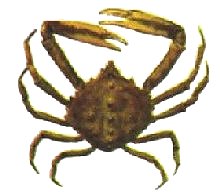
Small horseshoe crabs make unusual aquarium subjects, although eventually their bulldozing will upset the decor of the tank.
Other types of crabs, especially swimming crabs, are not recommended, since they spend their days buried in the sand, and their nights hunting. Also, all crabs grow by molting, so that the tiny harmless one you have can turn into a big killer overnight unless the fish tear it apart while it is vulnerable.

Crustaceans are sensitive to aquarium fish medications, although not as much so as other invertebrates.
Shrimps & other Crustaceans

Shore Shrimps ( right ) are easily collected for the aquarium, but hard to keep, as most fish think they are delicious. They should be thought of more as live food than pets, although they are interesting in their own right until they get eaten.
Gammarus ( below ) and other small crustaceans make excellent live fish food.
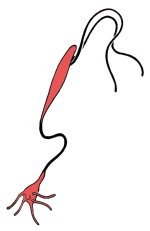
Of course, you would need a very large coldwater aquarium to keep a legal-sized lobster. Baby lobsters are very cute but would pose a great danger to their tankmates if it were legal to keep them in an aquarium.
Something you don't want in your tanks is the Ribbon Louse ( right. ) This is a parasitic copepod that preys on fishes.
Crustaceans are sensitive to aquarium fish medications, although not as much so as other invertebrates.
Freshwater
Check local regulations to make sure collecting them is legal. A freshwater fishing license may be purchased online for about $20. Collecting may be done with seines, dip nets, or rod and reel. For the last method, very tiny tackle is required: #12 hooks, 1/2" bobbers, and small bits of earthworm for bait. Fishing for sunnies can be very challenging and fun - they are expert bait stealers and scrappy little fighters. Minimum sizes for fishing also apply to aquarium specimens.
Carp, Goldfish & Suckers

Goldfish are closely related to Carp, but lack barbels. In the wild, goldfish grow up to 18", but lose their bright colors after a few generations.
Goldfish are gluttonous and messy. They are best kept amongst just themselves. No need to catch these, just go to the store. They do best in cold water but will tolerate a fair amount of heat as well.

Redhorse Suckers are quite attractive, sporting colorful fins, like some kind of tropical aquarium fish. They require cool, well-oxygenated clean water, and live foods. They are much less tolerant of excessively warm water.
Darters

In an aquarium, Darters are peaceful and shy and will take only live foods. If kept with larger fishes, they are likely to end up as food. Darters must be kept cool.
Catfishes

Catfishes make excellent aquarium cleaners. Small Bullheads may be collected in the wild. Channel cats (right) may be bought in the store as juveniles, often in ugly albino form, although the natural black-spotted gray form is rather attractive. Channel cats are more active and less nocturnal than Bullheads, although in time they will outgrow just about any aquarium.
Catfishes eat almost anything and lots of it. All catfishes are air-breathers to varying degrees and are highly tolerant of warm and low-oxygen environments.
Sunfishes & relatives

In Europe, North American fishes of the family Centrarchidae are popular coldwater aquarium subjects. Sunfish are found in almost any body of freshwater.
In most respects, Sunfish are very much like tropical cichlids. Unfortunately, this extends to the aggressiveness and territoriality that cichlids are famous for, which is heightened in the confines of an aquarium. This is a good reason to start out with small ones - they will grow up accustomed to each other, and will fight less, whereas a large one may not tolerate any other tankmate.
Adult members of the genus Lepomis, which includes all of the common species including Bluegills, Pumpkinseeds (above), and Redbreasts, become extremely aggressive in the confines of an aquarium. This aggressiveness crosses species and gender lines, as they will often not tolerate any sort of tankmate at all. For these types, a single adult male (females are drab) in a twenty-gallon aquarium makes a nice display. Two or three may get along in a 55-gallon aquarium.
Pumpkinseeds are the smallest of the three, and most suitable for the aquarium. They are also the most colorful and active. Redbreasts are somewhat larger and more calm, although given to occasional bouts of panic. Bluegills have nothing to recommend them - they are the most aggressive, least colorful, and biggest of all the common local Sunfishes. Fortunately, the above-mentioned species have very small mouths with which they can do little damage, but even so, their constant harassment of other fishes takes its toll and is no fun to watch either. Small juveniles may be kept in a large community tank, where they will squabble mainly amongst themselves. It is best to catch small juveniles and grow them up in the tank, rather than catching adults.

The genus Enneacanthus contains several small species that are highly suitable for aquarium keeping. The Banded, Blackbanded, and Bluespotted sunfishes are all fairly peaceful and very attractive. They are commonest in the Pine Barrens, although they may also be found in some more northerly drainages as well. Crappies (right), with their large mouths, would appear to be unsuitable, but are actually peaceful and shy, although somewhat difficult to feed. Basses of the genus Micropterus are generally too large to keep. They are aggressive predators and will harass any other fish that they cannot swallow.
While not tropical, Sunfishes are fairly tolerant of warm water, and generally do not require any special care in that regard. They benefit from a drop in temperature in the winter. Sunfishes are often covered with a tiny white threadlike parasite when caught, especially on the fins. This is not ich and will die off after several weeks in captivity, leaving the fish clean and healthy.
Shiners

The Golden Shiner is probably the most attractive of the minnows in our area, although only the male wears these colors, and then only when breeding. Otherwise, they are much drabber.

Another common minnow is the Bridled Shiner. All types of shiners may be kept in a cold-water aquarium, although they are particularly susceptible to ich. This can be a great problem since the parasite is much more difficult to treat at low temperatures.
Minnows like these are peaceful and inoffensive. At first, they may refuse fish foods, but in time they will adapt.
Crayfish

Crayfish are very interesting if kept alone in their own small aquarium. Mixed with other creatures, they cannot be trusted. They will scavenge almost any kind of food offered.
One thing you can do to make a crayfish safe in captivity is clip off the outer half of its "thumbs". In the absence of any predators, this will do the animal little harm, but will greatly reduce its ability to catch tankmates. On the other hand, many larger fishes have no problem dismembering a Crayfish.
Snails


Apple Snails ( right ) and River Snails ( left ) do quite well in captivity, feeding on algae and fish wastes.
Insects




There are a few types of aquatic insects that would make interesting aquarium subjects. The Backswimmer ( center ) and Water Boatman ( right ) are small sucking predators that would be difficult to feed. The Water Scavenger Beetle ( left ) and Giant Water Bug ( below ) are much larger. Also predatory, these would pose a very real threat to any small fishes in the confines of an aquarium. All of these insects are also quite good fliers, and would easily escape from all but the most well-sealed aquarium, into your house. They are probably best left to eight-year-olds to keep in a jar.
Higher Animals
Tadpoles are easily kept in captivity. They may be fed boiled spinach and the like, and some may even take fish foods. If you are successful, you will get to see it turn into a frog. Adult frogs are more difficult to keep. They require live food, and also some place to climb out of the water to rest. Newts are another common amphibian that may be kept in an aquarium. These are inexpensively acquired at the pet store.

Baby turtles are the subject of a number of idiotic laws forbidding their keeping in New Jersey. Apparently, you can get sick if you suck on them. Nonetheless, they make interesting pets and are easily fed on standard fish foods. They can be kept in a fish aquarium if they are given a small floating island to climb out on to rest and dry out. A piece of wood will often do. Do not keep them with large aggressive fishes which will harass or even kill them. I have heard stories of baby snapping turtles kept as pets, which apparently do quite well in solitary confinement.
Plants


Free-floating Duckweed ( left ) can be a source of food for vegetarian fishes. Hornwort ( right ) is a fast-growing water plant that is also available in pet stores.
Freshwater algae is not usually considered to be a desirable addition to an aquarium. It will generally form a green or brown slime or velvety fuzz on rocks, glass, and decorations.


